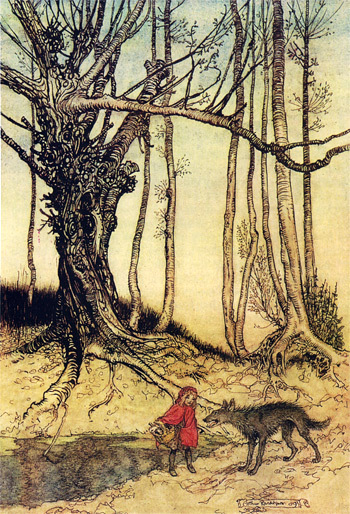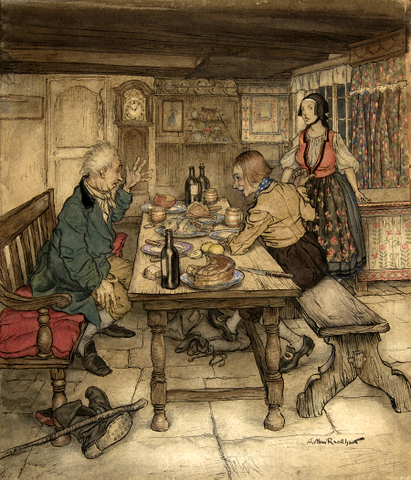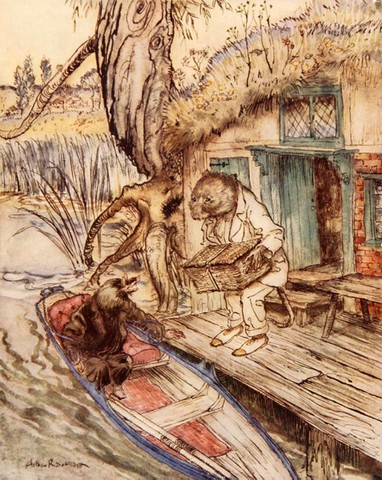RACKHAM, Arthur
Arthur Rackham was born at 2 St James's Terrace, Lambeth, London on 19 September 1867, fourth of the twelve children of Alfred Thomas Rackham (1829–7 May 1912), a legal clerk, and his wife, Anne Stevenson (1833–14 December 1920), daughter of a Nottingham draper. His father became chief clerk at the Admiralty registry in 1875 and Admiralty marshal at the High Court in 1896. Rackham grew up at 210 South Lambeth Road, South London and was encouraged to paint as a child, attending the City of London School 1879–1883 where he won prizes for drawing but left the school because of ill health. Taking voyage to Australia January to July 1884, then spending six weeks painting landscapes and plants in and around Sydney which renewed his health and became his informal apprenticeship to art. Rackham enrolled in evening classes at Lambeth School of Art, under William Llewellyn (1858-1941), with fellow students including Charles Shannon (1863-1937), Charles Ricketts (1868-1931) and Thomas Sturge Moore (1870-1944), who encouraged him to submit illustrations to magazines. To earn his living, Rackham became a clerk in the Westminster Fire Office 1885-1892, living in Buckingham Chambers, Strand he joined 'Pall Mall Budget' as a news and features illustrator, the following year moving to the 'Westminster Budget' and the 'Westminster Gazette'. Widening his practice by illustrating books for publishers, Rackham's first notable successes were illustrations to 'The Ingoldsby Legends' (1898), 'Gulliver's Travels' (1900), and 'Grimm's Fairy Tales' (1900) which were followed by 'The Greek Heroes' (1903), 'Rip Van Winkle' (1905), 'Peter Pan in Kensington Gardens' (1906), and 'Alice in Wonderland' (1907) developing his gift for drawing witches, gnomes, fairies, bringing them to a pitch of vivid characterization' and trees with human limbs and faces became one of his trademarks. However, Rackham always maintained a strict sense of reality by giving his figures human traits and foibles and naturalistic, even recognizable, settings—illustrations in 'A Midsummer Night's Dream' are variously set in Wimbledon Park, Ruislip churchyard, and Walberswick, Suffolk. He travelled extensively in Europe, particularly to Germany, the Alps, and Italy, painting in watercolour as a result, European landscape and architectural subjects peppered his illustrations and he developed a particular fondness for German literature and language. Rackham married at St Saviour's, Hampstead on 16 July 1903, painter Edyth Harriet Gertrude Gabrielle Starkie (1867–1941), daughter of William Robert and Frances Starkie and they lived at 16 Chalcot Gardens, Hampstead where each had a studio and their only surviving child, Barbara, was born in 1908. The First World War ruined the illustrated gift-book market bring Rackham a financial reverse and the principal market for Rackham's work came in the United States. In 1920 the Rackham's moved from London to Houghton House, Amberley, Sussex living there until 1930, with Rackham retaining a London studio at Primrose Hill. In 1927 he travelled to New York, Boston, and Philadelphia, returning with a commission from the New York Public Library to illustrate a unique copy of 'A Midsummer Night's Dream', to be written out by the calligrapher Graily Hewitt (1864-1952) which was completed in 1930. In 1930 he moved to Stilegate, the house they had built near Limpsfield, Surrey but the last few years of Rackham's life was interrupted by spells in hospital for both him and Edyth. During his last illness he worked on illustrations to Kenneth Grahame's 'The Wind in the Willows' which was published posthumously in 1940. Arthur Rackham was of Primrose Hill Studios, Fitzroy Road, London N.W.10 when he died at Stilegate, Limpsfield on 6 September 1939 and was cremated in Croydon.
Works by This Artist

|
Red Riding Hood |

|
Little Claus and Big ClausWatercolour, pen and ink, and gouache
|

|
From The Wind in the WillowsWatercolour
|